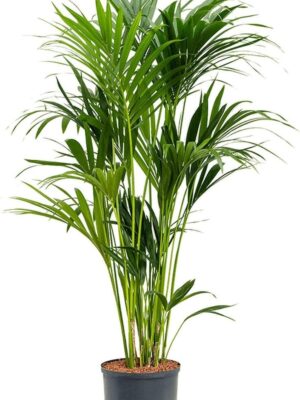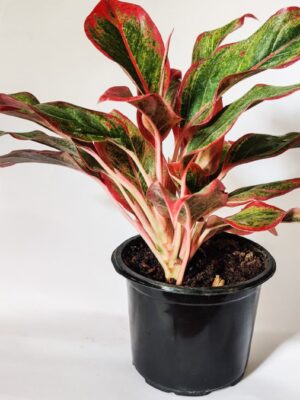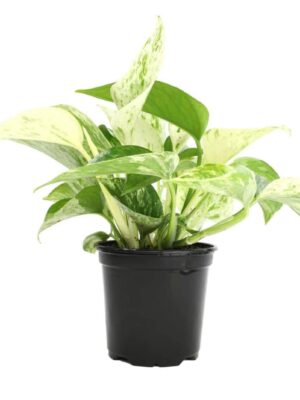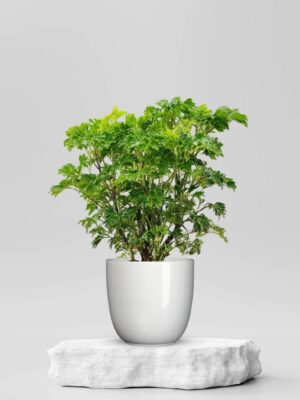Description
1. Botanical Overview:
-
Botanical Name: Syngonium podophyllum
-
Common Name(s): Arrowhead Plant, Goosefoot Plant, Five Fingers, Nephthytis
-
Family: Araceae
-
Native To: Tropical rainforests of Central and South America, primarily in regions like Mexico, Costa Rica, and Panama.
2. Appearance:
-
Leaves: Syngonium Green is known for its distinctive arrowhead-shaped leaves, which have a smooth, glossy texture. Young leaves are typically light green, and as they mature, they develop a more deep green color. The plant can have leaves that are sometimes white or cream variegated, depending on the variety.
-
Growth Habit: It is a vining plant that can either trail or climb, depending on the support provided. In its native environment, it grows as a ground-covering vine and climbs trees.
-
Size: Syngonium Green typically grows up to 3–6 feet long as a vine, though it can be pruned to maintain a more compact size for indoor spaces. It can also spread up to 2 feet in width.
-
Roots: The plant is known for producing aerial roots that help it climb or attach itself to support structures in the wild.
-
Mature Leaves: The leaves of mature Syngonium plants can split into 3–5 lobes, giving them a unique, fingery appearance, hence the common name “Five Fingers.”
3. Light Requirements:
-
Ideal Light: Syngonium Green thrives in bright, indirect light, which encourages robust growth and vibrant leaf color. It can tolerate moderate light but may not grow as vigorously or produce as many new leaves in lower light conditions.
-
Direct Sunlight: Prolonged exposure to direct sunlight can cause the leaves to scorch and turn yellow, so it is best to avoid direct sunlight.
-
Low Light Tolerance: Syngonium can adapt to low light conditions, but its growth will slow, and the leaves may become smaller or less vibrant.
4. Watering Needs:
-
Watering Frequency: Syngonium Green prefers to have its soil kept slightly moist, but it should not be waterlogged. Water when the top 1–2 inches of soil feel dry.
-
Signs of Underwatering: If underwatered, the leaves will begin to wilt and may turn yellow or brown at the edges.
-
Signs of Overwatering: Overwatering can lead to root rot, which manifests as yellowing leaves and soft, mushy roots. Ensure the pot has good drainage to avoid water retention.
-
Watering Tip: Use room temperature water, and avoid letting the plant sit in excess water. Ensure the soil drains well after watering.
5. Temperature & Humidity:
-
Temperature Range: Syngonium Green thrives in warm temperatures, ideally between 18–24°C (65–75°F). It should be protected from temperatures below 15°C (59°F).
-
Humidity: Being native to tropical regions, Syngonium plants prefer moderate to high humidity. To mimic these conditions, you can mist the leaves occasionally, use a humidifier, or place the plant on a humidity tray. While it can tolerate average indoor humidity, it will flourish in higher humidity.
6. Soil & Potting:
-
Soil Type: Syngonium Green prefers well-draining, aerated soil. A mix of potting soil, perlite, and some orchid bark or coco coir is ideal for good drainage and root health.
-
Repotting: Syngonium plants are fast-growing and will need to be repotted every 1–2 years. Repot in early spring, choosing a pot 1–2 inches larger than the previous one.
-
Drainage: Ensure the pot has adequate drainage holes to prevent water from accumulating at the bottom, which can lead to root rot.
7. Growth & Maintenance:
-
Growth Rate: Syngonium Green is a fast-growing plant, especially in the warmer months. It can grow up to 6–10 inches per month in optimal conditions.
-
Pruning: Regular pruning helps maintain the plant’s shape and encourages new growth. Trim back any leggy vines or dead leaves to promote a bushier plant. You can also cut back vines if they become too long or unruly.
-
Support: If you want the Syngonium to climb or trail, provide it with a moss pole or a trellis for support. If left unsupported, the plant will trail or cascade down the pot, which can also be attractive in a hanging basket.
-
Fertilization: During the growing season (spring and summer), fertilize Syngonium every 4–6 weeks using a balanced, diluted liquid fertilizer. Reduce fertilization in the fall and winter when growth slows down.
8. Air Purifying Qualities:
-
Like many other plants in the Araceae family, Syngonium is an air-purifying plant. It can help remove harmful toxins like formaldehyde, benzene, and xylene from the air, contributing to a cleaner indoor environment.
9. Toxicity:
-
Toxic to Pets: Yes, Syngonium Green is toxic to pets (cats, dogs) if ingested. It contains calcium oxalate crystals, which can cause symptoms like drooling, vomiting, and irritation of the mouth and digestive tract.
-
Human Toxicity: The plant is also mildly toxic to humans, especially if parts of it are ingested. Contact with the plant’s sap can cause skin irritation in some people. Always wash hands after handling the plant.
10. Benefits:
- Aesthetic Appeal: Syngonium is an attractive plant, perfect for brightening up spaces with its lush, vibrant green leaves and unique arrowhead shape.
- Air Purification: Known for its ability to purify the air by removing common indoor toxins.
- Easy to Care For: A relatively low-maintenance plant, ideal for beginners and people with busy schedules.
- Versatile Growth Habit: Can be grown as a vining plant or trained to climb with support, making it adaptable to various indoor environments.
- Fast-Growing: Syngonium plants are fast-growing, which makes them great for filling spaces quickly with greenery.
11. Common Problems:
- Yellowing Leaves: This can be caused by overwatering, underwatering, or low light. Ensure you water only when necessary and provide adequate light.
- Leaf Curling: Curling leaves can indicate low humidity or stress due to temperature changes or underwatering. Increase humidity or adjust the plant’s environment.
- Brown Tips: Brown tips on the leaves may result from low humidity, over-fertilizing, or salt buildup in the soil.
- Leggy Growth: Lack of light can cause the plant to become leggy and stretched out. Ensure the plant receives enough indirect light for compact growth.











 Aralia_plant
Aralia_plant
Reviews
There are no reviews yet.